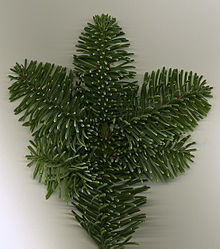- Abies procera
-
Abies procera
Noble Fir
Conservation status Scientific classification Kingdom: Plantae Division: Pinophyta Class: Pinopsida Order: Pinales Family: Pinaceae Genus: Abies Species: A. procera Binomial name Abies procera
Rehder
Abies procera, the Noble Fir, is a western North American fir, native to the Cascade Range and Coast Range mountains of extreme northwest California and western Oregon and Washington in the United States. It is a high altitude tree, typically occurring at 300–1,500 metres (980–4,900 ft) altitude, only rarely reaching tree line.
Contents
Description
Abies procera is a large evergreen tree typically up to 40–70 m (130–230 ft.) tall and 2 m (6.5 ft.) trunk diameter, rarely to 90 m (295 ft.) tall and 2.7 m (8.9 ft.) diameter,[1] with a narrow conic crown. The bark on young trees is smooth, grey, and with resin blisters, becoming red-brown, rough and fissured on old trees. The leaves are needle-like, 1-3.5 cm long, glaucous blue-green above and below with strong stomatal bands, and a blunt to notched tip. They are arranged spirally on the shoot, but twisted slightly s-shaped to be upcurved above the shoot. The cones are erect, 11–22 cm (4.3–8.7 in) long, with the purple scales almost completely hidden by the long exserted yellow-green bract scales; ripening brown and disintegrating to release the winged seeds in fall.
Abies procera is very closely related to Red Fir (Abies magnifica), which replaces it farther southeast in southernmost Oregon and California, being best distinguished by the leaves having a groove along the midrib on the upper side; Red Fir does not show this. Red Fir also tends to have the leaves less closely packed, with the shoot bark visible between the leaves, whereas the shoot is largely hidden in Noble Fir. Red Fir cones also mostly have shorter bracts, except in Abies magnifica var. shastensis; this variety is considered by some botanists to be a hybrid between Noble Fir and Red Fir.
Uses
Noble Fir is a popular Christmas tree. The wood is used for general structural purposes and paper manufacture.
References
- ^ "Gymnosperm Database - Abies procera". http://www.conifers.org/pi/ab/procera.htm. Retrieved 2008-06-28.
- Conifer Specialist Group (1998). Abies procera. 2006. IUCN Red List of Threatened Species. IUCN 2006. www.iucnredlist.org. Retrieved on 12 May 2006.
External links
Categories:- IUCN Red List least concern species
- Abies
- Trees of the West Coast (U.S.)
- Trees of California
- Trees of Oregon
- Trees of Washington (state)
- Klamath Mountains
- Least concern flora of California
- Least concern flora of the United States
Wikimedia Foundation. 2010.



